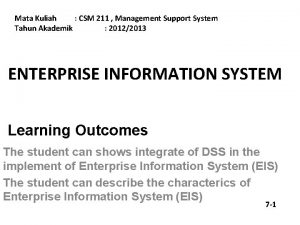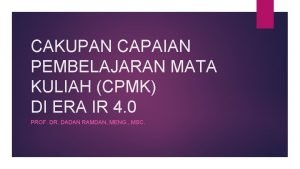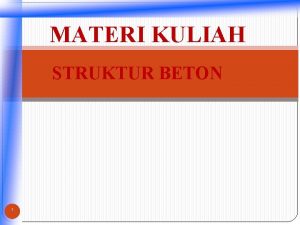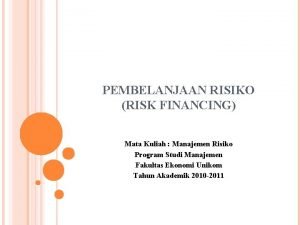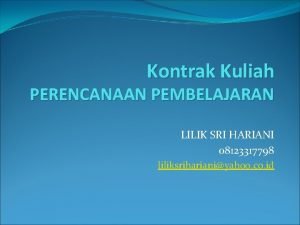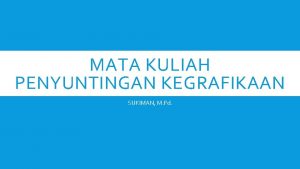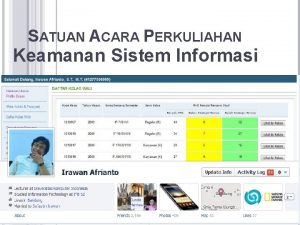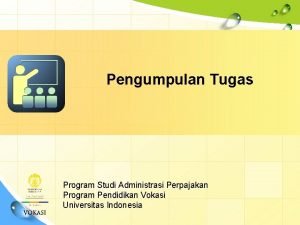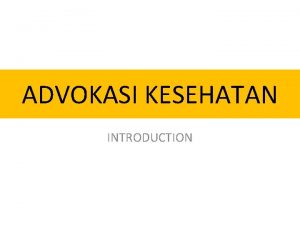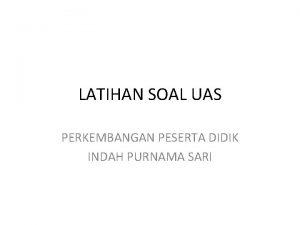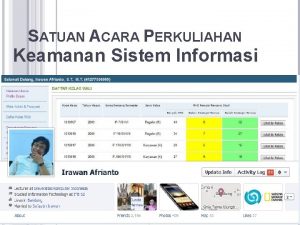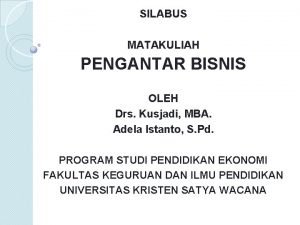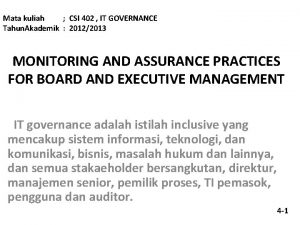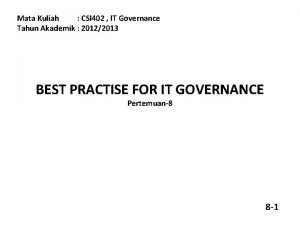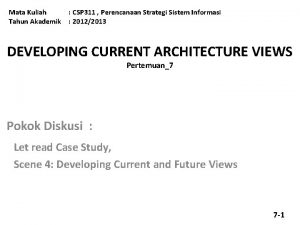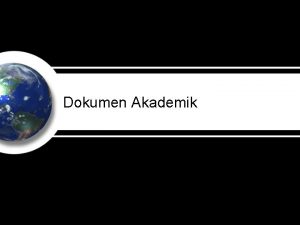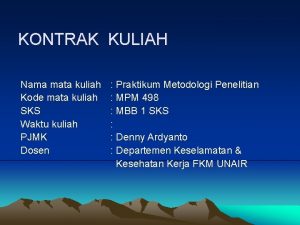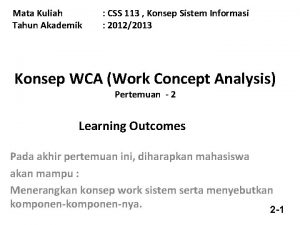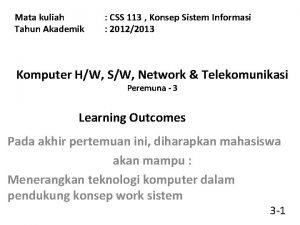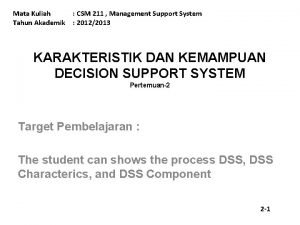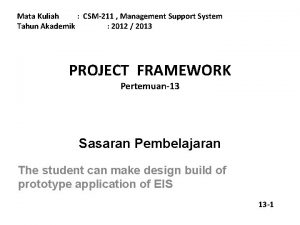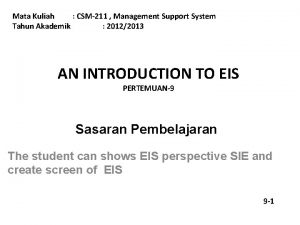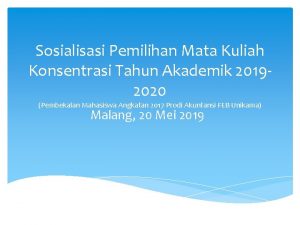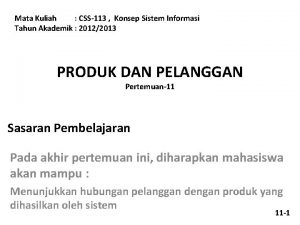Mata Kuliah Tahun Akademik CSP 402 IT Governance
















- Slides: 16

Mata Kuliah Tahun Akademik : CSP 402 , IT Governance : 2012/2013 INTERNAL CONTROL COMPONENT Pertemuan_6 SAS 78 / COSO Describes the relationship between the firm’s… • internal control structure, • auditor’s assessment of risk, and • the planning of audit procedures How do these three interrelate? The weaker the internal control structure, the higher the assessed level of risk; the higher the risk, the more auditor procedures 6 -1 applied in the audit.

Five Internal Control Components: SAS 78 / COSO 1. Control environment 2. 3. 4. 5. Risk assessment Information and communication Monitoring Control activities 6 -2

1: The Control Environment • • Integrity and ethics of management Organizational structure Role of the board of directors and the audit committee Management’s policies and philosophy Delegation of responsibility and authority Performance evaluation measures External influences—regulatory agencies Policies and practices managing human resources 6 -3

2: Risk Assessment • Identify, analyze and manage risks relevant to financial reporting: – changes in external environment – risky foreign markets – significant and rapid growth that strain internal controls – new product lines – restructuring, downsizing – changes in accounting policies 6 -4

3: Information and Communication • The AIS should produce high quality information which: – identifies and records all valid transactions – provides timely information in appropriate detail to permit proper classification and financial reporting – accurately measures the financial value of transactions – accurately records transactions in the time period in which they occurred 6 -5

4: Monitoring The process for assessing the quality of internal control design and operation [This is feedback in the general AIS model. ] • Separate procedures—test of controls by internal auditors • Ongoing monitoring: – computer modules integrated into routine operations – management reports which highlight trends and exceptions from normal performance 6 -6

5: Control Activities • Policies and procedures to ensure that the appropriate actions are taken in response to identified risks • Fall into two distinct categories: – IT controls—relate specifically to the computer environment – Physical controls—primarily pertain to human activities 6 -7

Two Types of IT Controls • General controls—pertain to the entitywide computer environment – Examples: controls over the data center, organization databases, systems development, and program maintenance • Application controls—ensure the integrity of specific systems – Examples: controls over sales order processing, accounts payable, and payroll applications 6 -8

Six Types of Physical Controls • • • Transaction Authorization Segregation of Duties Supervision Accounting Records Access Control Independent Verification 6 -9

Physical Controls Transaction Authorization • used to ensure that employees are carrying out only authorized transactions • general (everyday procedures) or specific (non-routine transactions) authorizations Supervision • a compensation for lack of segregation; some may be built into computer systems Accounting Records • provide an audit trail 6 -10

Segregation of Duties • In manual systems, separation between: – authorizing and processing a transaction – custody and recordkeeping of the asset – subtasks • In computerized systems, separation between: – program coding – program processing – program maintenance 6 -11

Access Controls • help to safeguard assets by restricting physical access to them Independent Verification • reviewing batch totals or reconciling subsidiary accounts with control accounts 6 -12

Nested Control Objectives for Transactions Control Objective 1 Control Objective 2 Authorization Processing Custody Recording Custody Control Objective 3 Authorization Task 1 Recording Task 2 Task 1 Task 2 6 -13

Physical Controls in IT Contexts Transaction Authorization • The rules are often embedded within computer programs. – EDI/JIT: automated re-ordering of inventory without human intervention Segregation of Duties • A computer program may perform many tasks that are deemed incompatible. • Thus the crucial need to separate program development, program operations, and program maintenance. 6 -14

Supervision • The ability to assess competent employees becomes more challenging due to the greater technical knowledge required. Accounting Records • ledger accounts and sometimes source documents are kept magnetically – no audit trail is readily apparent Access Control • Data consolidation exposes the organization to computer fraud and excessive losses from disaster. 6 -15

Independent Verification • When tasks are performed by the computer rather than manually, the need for an independent check is not necessary. • However, the programs themselves are checked. ======== thank for your attention ======== 6 -16
 Materi kuliah it governance
Materi kuliah it governance Mata kuliah erp
Mata kuliah erp Cpmk
Cpmk Mutu baja
Mutu baja Risk financing
Risk financing Mata kuliah pelayanan prima
Mata kuliah pelayanan prima Soal uas mata kuliah perencanaan pembelajaran
Soal uas mata kuliah perencanaan pembelajaran Mata kuliah penyuntingan
Mata kuliah penyuntingan Mata kuliah keamanan sistem informasi
Mata kuliah keamanan sistem informasi Mata kuliah geografi ui
Mata kuliah geografi ui Mata kuliah administrasi perpajakan ui
Mata kuliah administrasi perpajakan ui Mata kuliah advokasi
Mata kuliah advokasi Pertanyaan tentang tugas tugas perkembangan peserta didik
Pertanyaan tentang tugas tugas perkembangan peserta didik Mata kuliah keamanan sistem informasi
Mata kuliah keamanan sistem informasi Mata kuliah aplikasi komputer statistik
Mata kuliah aplikasi komputer statistik Mata kuliah ilmu kelautan unpad
Mata kuliah ilmu kelautan unpad Silabus mata kuliah pengantar bisnis
Silabus mata kuliah pengantar bisnis

